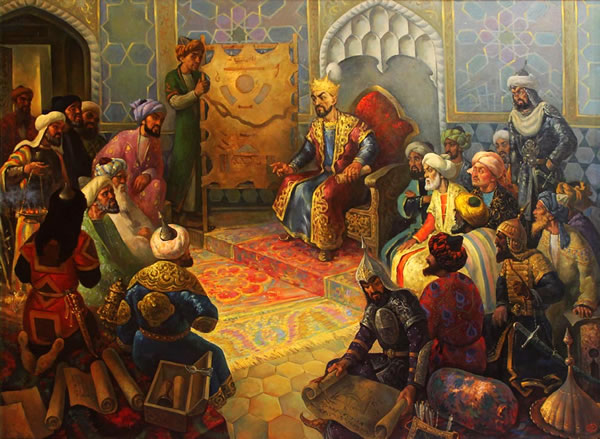Timurlane, or Timur the Lame, was the founder of the Timurid dynasty that lasted until 1506. Under the reign of the Timurid dynasty, culture, art, and trade experienced a successful revival and flourished in the region now known as Central Asia.
During his military career of about 50 years cut short by his death by pneumonia in 1405, Timurlane’s empire spanned most of Central and South-west Asia, from the Indus River valley to the Black Sea.
On April 11, 1336, Timurlane, also known as Tamerlane, Timur Leng (Persian), or Tamarlang (Arabic), was born in Kesh, also known as Shahr-e-Sabz, situated at the edge of the mountains just south of Samarkand, which would be the future capital of his empire.
  |
He was the son of a Turco-Mongol tribal leader of Barlas. His father was the first of his tribesmen to convert to Islam, and the young Timurlane, a Sunni Muslim, learned how to read the Qur’an.
In fact Timurlane often attacked the lands of infidels or other erring Muslims under the pretext of Islam, but this was only to justify his excesses. Similarly he maintained good relations with other Muslims for purely political reasons. His treatment of Muslims and non-Muslims who opposed him was similarly pitiless and brutal.
He earned the title Timur the Lame because of an injury in the leg sustained early in his life, either during a local rebellion, or by an arrow in the thigh shot by a farmer whose sheep Timur had stolen. Timurlane was very much inspired by another great leader and conqueror, Genghis Khan, the great Mongol conqueror of the 12th and 13th centuries.
 |
| Timurlane court |
Timurlane even claimed direct descent from Genghis Khan, although this has never been proved. Timur embarked on his grand quest to take over the world when he was only 21 years old. By 1358 he had already established himself as a military leader.
Timurlane’s army consisted mainly of Turks and Turkic-speaking Mongols. He began his campaign by subduing rival forces in Turkistan. By 1370 both Turkistan and Samarkand were under his control.
He established a stronghold in Samarkand, the capital city, in the form of a citadel in the western section with deep ravines around it. Samarkand became his favorite city, which he rebuilt into an opulent city with magnificent architecture in order to project himself as a wealthy and powerful ruler.
   |
He valued opulence so much that master craftsmen and artisans in each defeated country were spared from death. Instead Timurlane would employ them in order to build grand, imposing architectural structures in the lands that he conquered to reflect the grandeur and luxury of his empire.
From his military base in the city, Timur launched attacks on neighboring lands. His objective was to conquer as many countries as possible in order to gain taxable domains.
Timurlane and his ally Mir Hussain conquered Transoxania in 1364 by driving out the Chaqatai (Jagatai) khans. Breaking away from Mir Hussain, Timur marched onward to Khwarazm, a fertile zone lying on the southern shore of the Aral Sea, in 1371, where war was to last another eight years resulting in a victory for Timurlane. Timurlane crushed the Chagatai khans and annexed territory in the Tian Shan (T’ien-shan) mountains after three years of warfare there.
Timurlane continued to conquer land westward until he reached Herat (present-day Afghanistan) in 1381, the land of Toqtamish Khan of the Golden Horde, a successor of Genghis Khan’s world empire whom Timur had helped to conquer the White Horde. In 1386 Timur invaded western Iran, Iraq, and Georgia.
 |
| Timur defeating the Mamluk Sultan Nasir-ad-Din Faraj |
The method of massacre this time around was pushing men off the cliffs. In 1391 he took on Toqtamish. Toqtamish retreated, even though his forces were greater in number than those of Timurlane; as the morale of his forces dipped, Timur seized his land, harem, and treasures. Georgia was again attacked by Timurlane in 1399 and was defeated.
In 1400 Timurlane advanced into Anatolia, which had recently become part of the Ottoman Empire. Finally after taking Damascus and Aleppo, Timur faced his most formidable adversary, Bayezid I, the Ottoman sultan. In 1402 Timur besieged Ankara and after a grueling battle Bayezid was defeated.
Timur was also known for his sadistic cruelty in dealing with those who stood in his way during his conquests. He often launched savage massacres of his enemies and resistors such as in Delhi, where he slaughtered 80,000 individuals and built grisly pyramids of their skulls to commemorate his victory.
The same piling of skulls occurred earlier in Aleppo. In the late 1380s after a military rampage across the Middle East in Sistan, 2,000 people were laid in wet plaster and built into a briefly living tower. By the time he died, Timurlane had conquered expansive regions in Russia, Iran, India, and Central Asia.
Most historians agree that if not for his death, he would have attempted to conquer China as well. Timur is buried in the ostentatious Gur Emir mausoleum, covered in gold leaf and lapis blue. His tomb is made of nephrite jade; in contrast his other family members were buried in marble tombs around him.
 |
| Timur defeats the Sultan of Delhi |
